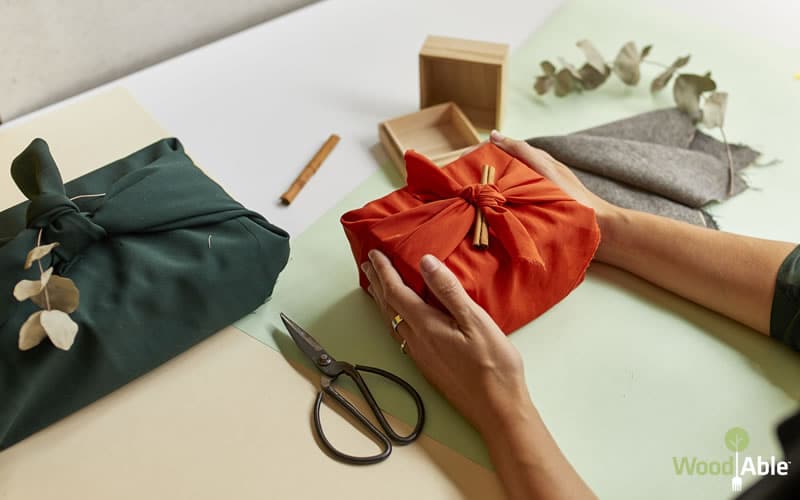WoodAble Blog
Approaching the Holiday with Zero-Waste Goals
By some estimates, each person generates close to five pounds of waste per day. That’s 1,825 pounds a year. We are not living in harmony with our environment. What can be recycled, repurposed or cut out entirely, especially as the most waste-accumulating season of the year is upon us?
When you choose to make being unwasteful a conscious lifestyle, this is called ‘zero-waste living’ or ‘sustainable lifestyle’. It’s not a new idea, but more akin to how our ancestors lived. When we make sustainability a priority, we’re cutting down on landfills and bad gas emissions to help restore the planet. During the holidays, here are some ways to live a zero-waste lifestyle:
Don’t resort to plastic cutlery and paper, plastic or styrofoam plates and cups for guests simply for convenience. If you don’t have enough plates and glasses, ask family members to loan out a few, or check with local thrift shops. They usually have entire sets of matching dinnerware for a very low price, plus Christmas specialty plates.
Store-bought cookies, for example, come wrapped in so much plastic packaging. Look for a cookie jar and make your own holiday cookies. You will also be making memories.
Invest in some silicone storage bags and wax paper instead of plastic wrap, zip bags and single use plastic containers. Recycle foil.
Serve iced tea, coffee and fresh water instead of bottled drinks. It will cut down greatly on things that must be recycled.
Don’t buy plastic holiday decorations, cheap plastic toys, gift wrap that has a slick plastic coating that makes it unrecyclable, plastic ribbons, bows, or purchases that come in fancy holiday gift packaging that is pretty to see but will go straight into the trash can.
Home delivery is a problem especially during the holidays, with wasteful boxes, packing materials and truck emissions. For Christmas alone, UPS and Amazon talk in terms of millions (and Fedex: billions) of packages being delivered. When possible, choose the Single Shipment option for your order. Also consider making joint bulk purchases with neighbors or friends if you are planning to order from the same place.
A crafty person with a sewing machine can repair clothing and turn used items into something that continues to be useful as doll clothes, pet pillows, aprons, tote bags, burp cloths and even ambitious projects like a quilt. Fabric is fabric, so don’t let its primary use keep you from creating other uses for it.
Start a tradition of using the same gift boxes or bags each year, or give gifts in specially chosen permanent containers that can be used year-round. The same gift wrap can be reused to wrap smaller gifts the following year and so on, until it becomes a name tag. Try reusable real ribbon. Cut the ends in an inverted V shape to keep them from unraveling. Re-gifting? If you don’t want something you’ve been given, there is a good chance you know someone who can use it. That’s not being thankless; that’s repurposing.
Extreme heat, drought and fires have decimated trees in the US. Help to save the trees. Forgo the freshly cut Christmas tree, and get a realistic faux tree that will last for many years. Or have a living tree planted in the front yard to decorate each year. You can still enjoy the fragrance of the forest inside with live-trimmed evergreen wreaths and sprays.
Shop secondhand stores and online places such as ebay, craigslist, freecycle, nextdoor and even facebook to find gifts or household needs close by. Where else can you pick up two additional chairs for the holiday table at a moment’s notice?
This time of year is a very special event at most antique shops. Antiquers cherish the memories of Christmas, and often host their guests with wassail, delicious treats plus a little Nat and Bing. This is a great place to find amazing one-of-a-kind gifts and special boxes to put under the tree.
Find or start a Christmas swap meet instead of shopping for more things. This is usually a one-day event to exchange decorations, clothes, toys, etc. Usually the rules are ‘as needed’ or ‘bring five, pick five’ or ‘bring a bag, take a bag.’ Chances are you’ll also make a friend with similar interests.
After the decorating, dinners and the delights of gift-giving, clean-up should be a snap. You can compost non-animal kitchen scraps, wreath and garland material in the backyard or a community compost bin, and store most of what you have used for wrap and decorations for next time. Here’s to a happy New Year and a healthier earth!

